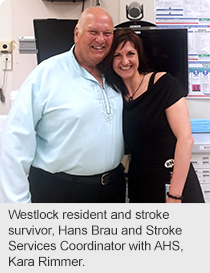
June 16, 2015
Story by Mark Evans
When Hans Brau’s right leg started to feel wobbly and a little numb his wife immediately said, “Let’s go to the hospital.”
The 64-year-old Westlock resident had noticed his leg was feeling a little weaker, but the numbness made them worry about a possible stroke and they knew they needed to get to a hospital quickly.
“Hospital staff immediately took blood tests, did a CT scan and I was connected with the stroke specialist in Edmonton who could see the scan, know my symptoms and talk to the doctor in Westlock. They identified a black spot in my brain and diagnosed it as a stroke,” says Brau.
 He spent three nights in hospital in Westlock during which time he had a second CT scan that looked at his neck which found more blood clots in some arteries.
He spent three nights in hospital in Westlock during which time he had a second CT scan that looked at his neck which found more blood clots in some arteries.
Brau was put on a variety of medications, including blood thinners, to clear the clots and his stroke symptoms started to go away, he says.
Westlock is a one of 13 primary stroke centre sites in the province that offer Stroke Unit Equivalent Care which means it aims to deliver the same level of care that is provided at urban centres, explains Kara Rimmer, Stroke Services Coordinator.
A primary stroke centre is a hospital that has a CT Scanner and the capability to provide the clot-busting drug, tissue plasminogen activator (tPA), which involves being able to quickly connect directly with stroke specialists at the larger hospitals to review the scans and determine the appropriate treatment.
“Offering Stroke Unit Equivalent Care also means the facility implements consistent processes to ensure patients coming into facilities get the tests they need and care they need in the hospital and after they get home,” says Rimmer.
“I was very impressed with the care I got at the Westlock Healthcare Centre and the immediate response of the physicians, says Brau. “Most important for me and my wife was the explanations we received. Everything was explained to us: what happened and what action we have to take to prevent it from happening it again.”
Brau continues to take his medication and do physiotherapy to regain his strength and mobility. He’s started to ride his bike for exercise. The first couple of days were pretty shaky, but he continues to get stronger and steadier every day, he says.
“It’s scary when you think something could have happened to your face or you could have paralysis, but there was no fear because the staff were so thorough and took their time and explained everything,” he says.
Knowing the signs of a stroke and calling 911 to get to a primary stroke centre is the best way to ensure you get the care needed says, Rimmer.
Symptoms of a stroke happen quickly and can include sudden weakness, or loss of movement in your face, arm, or leg, especially on only one side of your body; trouble speaking or understanding, vision problems; balance problems or a severe headache that is different from past headaches.
“The sooner treatment starts the better the outcome is for the patient,” says Rimmer. “If we can give the right drugs or start other treatment as soon as possible after a stroke, the sooner we may be able to minimize the long-term effects of stroke and prevent further complications.”